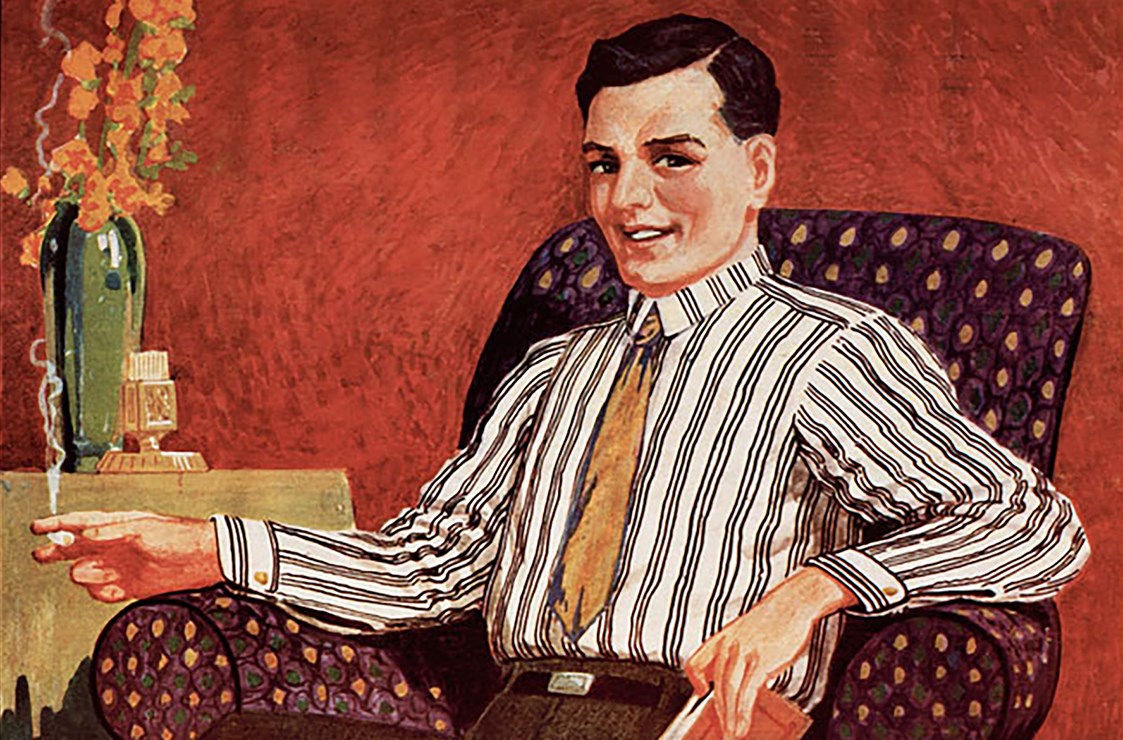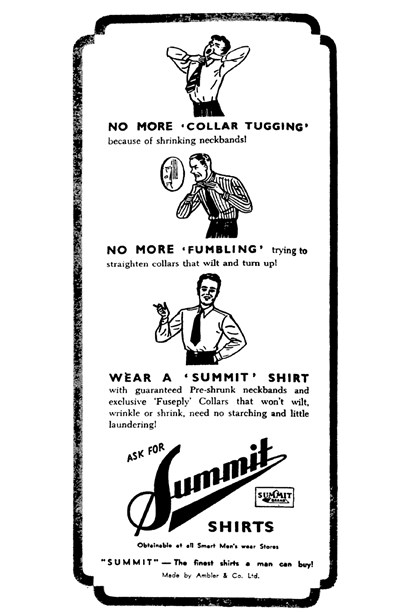Stories
Ambler & Co
1919-

An unwanted roll of broad-striped pyjama cloth led to business success for Auckland manufacturer Fred Ambler, when he made it into bold shirts for men in the rather conservative society of 1920s Auckland.
Frederick Norman Ambler was born in Yorkshire in 1894. He emigrated to Christchurch with his family in about 1907. His first work experience was milking cows, but he was soon employed in the garment industry with a job at Kaiapoi Woollen Mills.
Fred left New Zealand in 1917, as part of the New Zealand Rifle Brigade. He was seriously wounded in the war, and on his return to Christchurch in 1919 he married Ella Shelton. They moved to Auckland and that same year Fred set up his own business after applying for assistance to the Patriotic Fund. He was awarded a grant of 50 pounds and an interest free loan of 150 pounds to open Ambler & Co on 9 May 1919.
The business occupied a small work room on the 3rd floor of the Commercial Buildings at 153 Albert Street. Initially Fred employed six machinists to manufacture ladies blouses and men’s shirts and pyjamas. He worked with retailers on a 'cut, make and trim' basis. But when Fred could not sell pyjamas made from a broad-striped cotton pyjama cloth he had purchased, he decided to make it up as a shirt. His enterprise was rewarded. As something new and different, he easily sold the whole line. Fred continued to buy bold pyjama patterned fabric for his shirts, learning a valuable lesson that Summit products must be distinctly different.
His business quickly expanded and the roles became more specialised. In a situations vacant advertisement, Ambler & Co called for "Machinists for all branches of shirts - shirt machinists, collar machinists, pyjama machinists, needle machinists and improvers and apprentices" (Auckland Star, 9 January 1923). At this time collars were a separate component from the shirt body. They were laundered and starched before being attached.
By 1925 the business had outgrown the Albert Street location and Fred sought to build his own factory. Sourcing the capital to undertake such a big investment was a challenge. The respect he had earned in the business community however stood him in good stead and he was able to secure the support he needed from his landlord, Mr P H Ferguson and Smith & Caughey’s, Andrew Caughey.
In 1926 Fred visited J Forsyth & Company in Toronto, Canada. The visit inspired the Ambler & Co slogan 'No one ever regretted buying quality'. He also brought back machinery which revolutionised shirt manufacturing. Rather than one person making a whole shirt, machinists used specialist machines to do a single operation. This innovation met opposition from the trade union secretary, who was worried that if her girls left Ambler's factory, they would not be able to get another job since their experience was so limited. Fred pointed out that other firms would soon have to get the same sort of specialist machinery to compete and before long would be only to keen to get Ambler girls who were experienced in working them, and this is exactly how it worked out.
On that same trip Fred visited England and secured the licences for Aertex from the Cellular Clothing Co Ltd, and Viyella from William Hollins & Co Ltd.
By 1929 Fred was established as part of the Auckland business community. He regularly spoke about the manufacturing industry, giving a humorous talk titled 'The Tale of the Shirt'. In a 1929 presentation to the Auckland Rotary Club, he outlined the evolution of the shirt-making industry before detailing the manufacturing operations current in the industry today (New Zealand Herald, 15 October 1929). There were 26 different parts to a shirt, Fred explained, "and if any single one became misplaced considerable trouble ensued". Fred explained that local fashions in shirts closely followed those in vogue in England, "despite all that might be thought to the contrary, the young man of today was as fastidious as his sister". He concluded his talk by insisting that New Zealand shirts were as good in quality and better in price than the imported article and the industry was deserving of the utmost encouragement.
1940s era ads for a Summit shirts. No known copyright.
Fred was deeply involved in what was an early 'buy New Zealand-made' campaign. As an active member of the Manufacturers Association (including a stint as president in 1940-42), he was concerned at the effect of cheap imports on the industry. During his time as head of Ambler & Co, the industry faced many challenges. As well as competition from imports, there were protests against poor working conditions and pay, and during the Second World War a large part of the company’s production capacity was required by the government for the manufacture of army uniforms.
Import licensing had been introduced after the great Depression of the 1930s and, by the 1950s the business was booming. Product demand required more manufacturing capacity and new factories were built in suburban Browns Bay and Glen Eden.
Fred’s involvement in the business sector led to a long spell serving on the Auckland City Council. In 1959 he was appointed Deputy Mayor under Sir Dove Myer Robinson. Fred’s son, Norman, took over as managing director of Ambler & Co in 1964.
Norman also expanded the business, building a warehouse and cutting room on the corner of King Street and Great North Road in Grey Lynn. At its peak of local production, Ambler & Company employed over 400 people over their four Auckland sites and provide daycare for the children of staff in a purpose built centre behind the Grey Lynn premises.
Ambler & Co garments were sold in department stores, womenswear and menswear shops all over New Zealand. In addition to the Aertex and Viyella labels, Ambler manufactured Van Heusen, Hathaway, Mary Quant and Pierre Cardin under licence. But the majority of Ambler’s production was sold under the Summit label - a household name in New Zealand. Ads from the 1940s proclaim the virtues of pre-shrunk neckbands and the 'Fuseply' collars that didn’t require starching or heavy laundering (a quality greatly appreciated by those who did the laundry).

'Fuseply' collars didn’t require starching or heavy laundering - a quality greatly appreciated by those who did the laundry. Image from the Auckland Star, 11 June 1941. No known copyright.
Fred thought only in terms of the highest in quality, hence he adopted 'Summit' for the brand name. A sign with the words, 'Keep up the Quality' was erected in the Wellesley Street factory on the day it opened.
Norman’s son David Ambler started work in the cutting room in the 1970. He was party to the huge changes to the company that arose from the Government’s trade liberalisation policies in the 1980s. As import tariffs reduced and cheap imported goods flooded into the market, the company consolidated its operations. They began exporting to Australia and also importing goods thereby reducing their own production.
The Glen Eden and Browns Bay factories were closed in 1985 and 1990. In 1998, Ambler acquired Klipper John Webster and Innsbrook - the two businesses made dressing gowns, ties and trousers - a natural fit to complement Ambler’s shirts. The Ambler & Co building in Wellesley Street was sold in 2004 after the last of the production was moved to Grey Lynn in the late 1990s. In 2012 the company moved from its Grey Lynn buildings to premises at 481 Rosebank Road in Avondale.
On 1 September 2017 the business of Ambler & Co Ltd was sold to Cambridge Clothing Ltd. The fourth generation of the Ambler family, David’s son Christopher, remains with the new business.
Text by Kelly Dix. Banner image from Sir George Grey Special Collections, Auckland Libraries, 7-C1827. Image © unknown.
Last published September 2017.